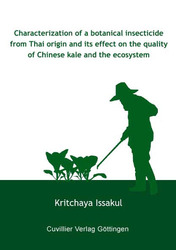| Areas | |
|---|---|
| Serie de libros (96) |
1378
|
| Nachhaltigkeit |
3
|
| Gesundheitswesen |
1
|
| Letra |
2363
|
| Ciencias Naturales |
5406
|
| Matemática | 229 |
| Informática | 319 |
| Física | 980 |
| Química | 1363 |
| Geociencias | 131 |
| Medicina humana | 243 |
| Estomatología | 10 |
| Veterinaria | 108 |
| Farmacia | 147 |
| Biología | 835 |
| Bioquímica, biología molecular, tecnología genética | 121 |
| Biofísica | 25 |
| Nutrición | 45 |
| Agricultura | 1004 |
| Silvicultura | 201 |
| Horticultura | 20 |
| Ecología y conservación de la tierra | 148 |
| Ciencias Ingeniería |
1791
|
| General |
98
|
|
Leitlinien Unfallchirurgie
5. Auflage bestellen |
|
Erweiterte Suche
Characterization of a botanical insecticide from Thai origin and its effect on the quality of Chinese kale and the ecosystem (Tienda española)
Kritchaya Issakul (Autor)Previo
Indice, Datei (24 KB)
Lectura de prueba, Datei (66 KB)
Botanical insecticides derived from plants may be an alternative to the use of chemical pesticides. In general, they may consider being beneficial, safe to human and the environment. However, some of botanical pesticides have adverse effects. In this study, nine species of Thai local plants were selected for their highest insecticidal activity. Mammeasiamensiswas selected for purification and chemical identification of the active compound. Surangin B was identified as the active compound which had a higher insecticidal activity on the larvae of diamond back moths than methomyl insecticide. Crude ethanolic extract of M. siamensiswas formulated as emulsifiable concentrate (EC). The quality control of the extract from each batch was carried out with HPTLC.
In the field study with Chinese kale, the mammea insecticide was slightly less efficient in the insect control than the synthetic methomyl insecticide. However, it showed a better effect in controlling the population of diamondback moth larvae than the studied synthetic insecticide. Moreover, the environmental friendly effect was also demonstrated by giving a slightly higher number of beneficial insects (natural enemies) than the methomyl treated and the control groups. Nevertheless, the yield of Chinese kale sprayed with mammea insecticide was not significantly different from that of the control group.
In the net green house no insect pest interference was observed and mammea insecticide had a tendency to increase the yield of Chinese kale. Most of the physical plant properties i.e. height, fresh weight, dry weight, number of leaf and leaf length of Chinese kale were slightly higher than those after methomyl treatment and the control, respectively. Furthermore, all the analyzed quality parameters i.e. chlorophyll and carotenoid contents, reducing sugars, total dietary fiber, total ascorbic acid, total antioxidative activity, ascorbate peroxidase activity and free amino acid contents were not significant different. From these results, it could be generally concluded that mammea insecticide had no adverse effect on both physical and quality parameters of Chinese kale.
Furthermore, mammea insecticide showed no significant negative effect on the ecosystem. Its active ingredient had a shorter persistence in the environment than the insecticide methomyl. Its residue was found on Chinese kale only one day after spraying whereas in soil and water no residues were already detected at the day of harvest. The toxicity of mammea insecticide on non target organisms was also studied. The results showed that it had no toxic effect on both earthworm and honeybee. However, it was more toxic in Tilapiathan methomyl insecticide. Nevertheless, because of its short-term persistence on environment, it could be assumed that under real field conditions the application of mammea insecticide followed the instruction (0.5 gL-1) might not produce a strongly adverse effect on any aquatic organisms.
Therefore, from its insecticidal effectiveness especially on diamondback moth, with no significant adverse effects on vegetable quality and the ecosystem, the mammea plant extract could be one of the potentially natural resources for a botanical insecticide.
| ISBN-10 (Impresion) | 386727309X |
| ISBN-13 (Impresion) | 9783867273091 |
| ISBN-13 (E-Book) | 9783736923096 |
| Formato | A5 |
| Idioma | Inglés |
| Numero de paginas | 116 |
| Edicion | 1 |
| Volumen | 0 |
| Lugar de publicacion | Göttingen |
| Lugar de la disertacion | Göttingen |
| Fecha de publicacion | 27.07.2007 |
| Clasificacion simple | Tesis doctoral |
| Area |
Agricultura
|
| Palabras claves | Pflanzenproduktion, Biochemie, Organische Chemie, Mikrobiologie |








